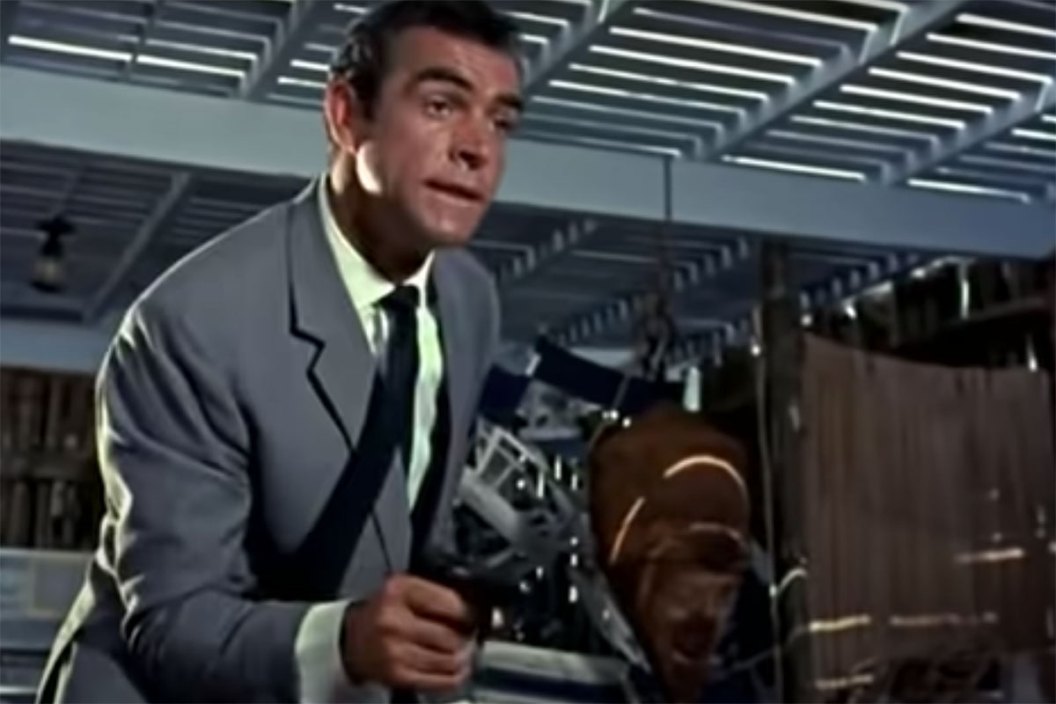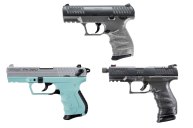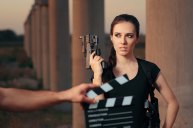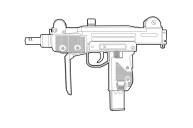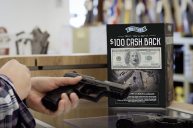Read our breakdown of all the firearms used in the very first James Bond movie from 1964, starring the late Sean Connery.
In 1953, author Ian Fleming introduced the world to a character that would become the most famous spy ever, real or fictional: James Bond, also known as Agent 007, serving in the British Secret Service.
Fleming featured Bond in a dozen novels and two short-story collections before he died in 1964, two years after his character was first introduced to the silver screen.
After Hollywood released the first Bond film in 1964, the character would go on to be featured in 24 (soon to be 25) movies released steadily over the years with six actors portraying him over the span of seven decades.
It all started with Dr. No, an adaptation of Fleming's sixth Bond book published in 1958, with 007 played by the incomparable Sean Connery.
In this inaugural adventure, Bond is sent to Jamaica to find out what happened to a fellow agent who disappeared on assignment. He uncovered the secret underground base of the titular Dr. No, a lunatic plotting to disrupt an early American space launch from Cape Canaveral. Don't forget, humanity was still five years away from taking its first steps on the moon, so this was very relevant and current subject matter.
As this was not the first Bond story, some pieces were borrowed from earlier Bond novels to introduce the character to film audiences, including his preferred weapons.
A big part of the Bond movies and his fieldcraft, such as it is, including an array of high-tech gadgets and gizmos that range from items based on real spy gear to the absolutely absurd and outlandish. He always has an awesome vehicle outfitted with all kinds of hidden weapons and gadgets, plus an ejection seat. There's always an ejection seat.
Through it all, as the gadgets and cars came and went, Bond always had his trusty, concealable sidearm, usually stowed in a discreet shoulder holster beneath a dinner jacket.
Guns Used by James Bond
In Dr. No, there's actually a good amount of dialogue devoted to Bond's pistol, which mirrors descriptions in Fleming's books.
Early in the movie, Bond meets with his boss, M (Barnard Lee) and the MI-6 armorer, and turns in what has been his regular sidearm up to that point, a "Beretta M1934 in 9mm Corto." In its stead, he receives was is said to be a Walther PPK in 7.65mm (7.65x17mm or .32 ACP), which is further described as more powerful than Bond's Beretta. This doesn't actually make sense, but we'll get to that in a second.
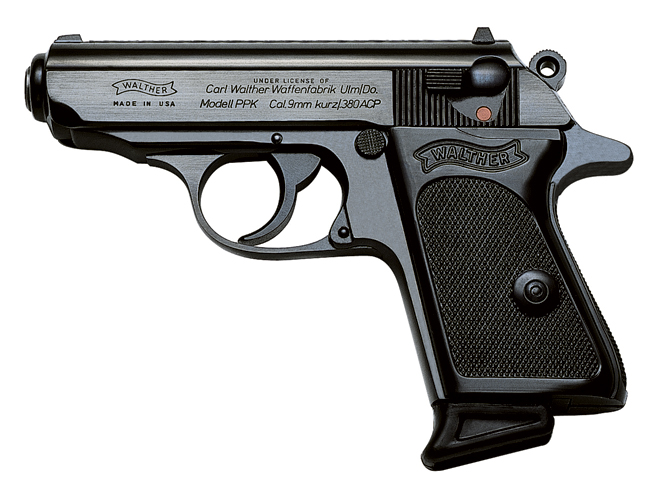
Walther
Bond laments to M that he has carried his Beretta for 10 years and has never missed with it. M responds by reminding Bond that his pistol jammed on his last assignment, leading to a grave injury.
First off, the gun Connery uses in Dr. No is not actually a PPK, but an earlier Walther PP pistol, which is very similar.
Now, while this bit of dialogue is pulled almost verbatim from Fleming's book, the guns Bond is turning in are different. In the book, Bond's old gun was a Beretta 418 in .25 ACP. Also, his recent injury wasn't due to the gun jamming, but to it getting caught on his clothes when drawing it, which caused him to get stabbed with a poisoned blade.
Also, a PPK in .32 ACP is not more powerful than a 9mm Short, as the movie would have you believe. However, it is more powerful than the round and gun Fleming originally had Bond carrying, the Beretta 418 and the diminutive .25 ACP. So, while the filmmakers kept faithful to the source material, changing the Beretta model made the dialog inaccurate.
During the scene where Bond assassinates Professor Dent (Anthony Dawson), he uses a suppressed pistol to do so, but if you look close, you'll see it's not his Walther, creating a continuity error. In later films, Bond often uses a suppressor with his PPK, but in this first film he's clearly using an FN Browning Model 1910 pistol in the assassination scene, ultimately for unknown reasons.
The First Gun-Barrel Shot
Dr. No established a lot of traditions and tropes that would become regular features of Bond movies, including the score and an opening sequence, beginning with a cold open followed by a musical intro. It was also the first time audiences saw the now famous gun barrel shot.
The gun barrel shot was striking at the time, providing the audience with a view from the inside of a gun barrel, the rifling framing the screen. The barrel swings as Bond pivots and shoots toward the camera. A veil of red then falls over the screen.
This was achieved by actually filming through the barrel of a Smith & Wesson Model 27-2 .357 Magnum revolver with a 3.5-inch barrel. And that guy in the suit and hat who shoots at the camera, that's not Sean Connery, but stuntman Bob Simmons. He redid the same shot for From Russia with Love and Goldfinger.
Other Characters' Guns
Two of the "Three Blind Mice" assassins use M1911A1 pistols fitted with suppressors to murder Strangways at the beginning of the movie. The third assassin uses a Webley & Scott Mk I revolver.
Professor Dent also uses a suppress M1911A1 when he tries to kill Bond.
Strangely, Bond identifies the gun as a Smith & Wesson that holds six bullets: "That's a Smith & Wesson, and you've had your six."
Obviously, the dialog was originally meant to refer to a revolver but was never changed after the prop gun was chosen. In 1964, S&W had never made a 1911-style pistol, and most 1911s hold seven or eight rounds in the magazine.
Dr. No's various henchmen are armed with a variety of guns. They use a Bren gun when searching for Bond. Others carry Sten Mk I submachine guns on Crab Key, most notably when Quarrel dies and Bond is decontaminated.
Legacy and Changes Over the Years
Dr. No was made on a tight budget, but it was extremely successful at the box office and launched a mammoth film franchise.
Bond would use a Walther PPK in nearly every single movie, with only a few exceptions. In Moonraker, with Roger Moore playing 007, the character never uses a handgun at all, though he was featured holding a PPK in promotional materials.
In 1983 something weird happened. Two Bond movies were released by competing studios due to a legal dispute. In 1973, Moore took over the role with Live and Let Die. In 1983, he starred in Octopussy, in which he carried a Walther P5 pistol instead of the PPK.
At the same time, Sean Connery was once again reprising the role of 007 in a Bond movie that was not an official part of the official EON Productions series of films, because of a dispute over the rights to the source material in the courts. Never Say Never Again was actually a new adaptation of the Fleming novel, Thunderball, which Connery had already done during his original stint as Bond. The movie didn't have any of the classic Bond movie music or the distinctive intro, but it had the original Bond, and he was also carrying a Walther P5 instead of the PPK.
It seems Walther realized that, by 1983, everything from the suit Bond wears and the car he drives to the watch on his wrist and the gun in his shoulder holster were marketing opportunities, and they somehow convinced the makers of both movies to include their brand new cutting edge P5 pistol instead of the older PPK. They were the P5 pistol's only appearances in Bond movies.
Other things changed over the years. For a while, Bond ditches his Aston Martin for a BMW during the Pierce Brosnan era.
As for the Walther PPK, George Lazenby carried one during his single turn as Bond. Timothy Dalton also carried a PPK and so did Pierce Brosnan before the latter traded it for a Walther P99 in his last couple Bond movies.
When Daniel Craig took over the role, his first James Bond film was adapted from the first James Bond novel, Casino Royale and was presented as a reboot for the series and the character. He uses a Walther P99 for most of the movie, in keeping with his predecessor Brosnan, but we see him use a PPK in a flashback. In the rest of his films, including Skyfall, Craig actually switches back to the older PPK as his go-to gun.
NEXT: GUNS FROM MOVIES: BLACK RAIN
WATCH
